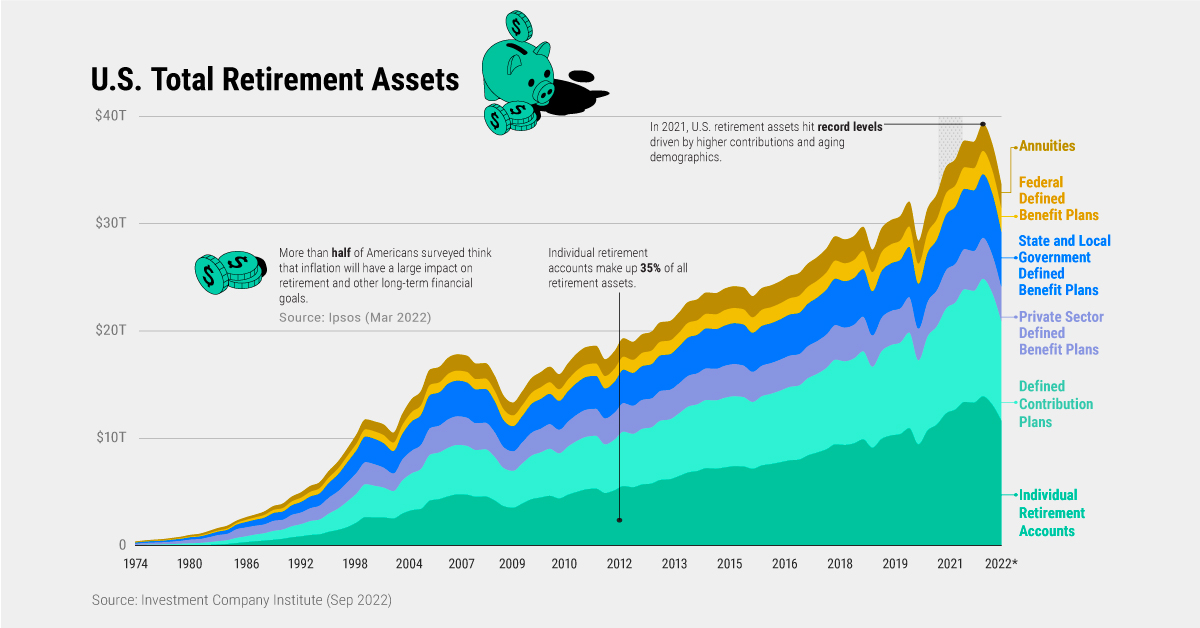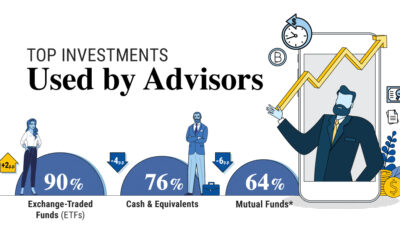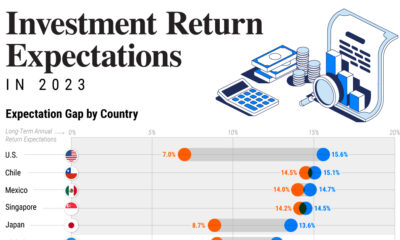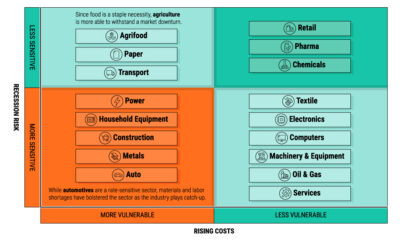This infographic is available as a poster.
Chart: The State of U.S. Retirement Assets in 2022
Today, many people are questioning the effects of high inflation on their retirement assets.
This Markets in a Minute from New York Life Investments charts the state of U.S. retirement assets to show how Americans are building their retirement savings, and where these assets are being drawn from.
U.S. Retirement Assets: Where it Stands Today
As of 2022, there was over $33 trillion being held in U.S. retirement assets.
For perspective, that’s about 31% of all household financial assets in America and nearly double the amount seen a decade ago. In the table below, we show how this breaks down by retirement asset type, using data from the Investment Company Institute:
| Type of Retirement Asset | 2022* | 2012 | 2002 | 1992 | 1982 |
| IRAs | $11.7T | $5.8T | $2.5T | $872B | $67B |
| DC Plans | $9.3T | $5.2T | $2.6T | $1.1T | $264B |
| State and Local Government DB Plans | $5.1T | $3.2T | $2.1T | $958B | $260B |
| Private-Sector DB Plans | $3.2T | $2.7T | $1.7T | $1.1T | $479B |
| Federal DB Plans | $2.2T | $1.3T | $800B | $411B | $99B |
| Annuities | $2.2T | $1.7T | $899B | $473B | $180B |
| Total | $33.7T | $19.9T | $10.5T | $5.0T | $1.3T |
*As of Q2 2022.
As seen above, individual retirement accounts (IRAs) hold the most retirement assets, at 34% of the total. Since 2012, they have doubled, jumping from $5.8 trillion to $11.7 trillion in 2022.
Today, about 37% of Americans hold an IRA.
With $9.3 trillion in assets, defined contribution (DC) plans are the second-greatest source of savings. These type of plans have the employee make contributions that are automatically deducted from their paycheck. Here, employers have the option to make contributions. Like IRAs, they have grown considerably in the last 10 years.
Defined benefit (DB) plans, meanwhile, have declined in usage, especially in the private sector. In 1982, private-sector DB plans made up almost 40% of U.S. retirement assets. In 2022, they accounted for under 10% of these assets.
Overall, retirement assets have declined in 2022 due to weak market performance—after a record year in 2021 driven by higher contributions, a strong market, and other factors.
U.S. Financial Security in 2022
With these factors at play, how are Americans feeling about their financial security, and how is this impacting their retirement outlook?
In one Ipsos survey, just 56% of Americans surveyed said they felt good about their overall level of financial security.
When it comes to their long-term outlook, chief among concerns is inflation. Over half surveyed said that it will likely have a big impact on their ability to save for retirement and meet other long-term financial goals. Rising interest rates and medical costs are other areas of concern, with about one-third saying they will have a large impact on achieving these outcomes.
Meanwhile, 59% of Americans said they feel confident they have enough savings to enjoy a comfortable retirement. Of these, Baby Boomers feel most confident at 70%, while Gen Z (48%) feels least confident.
The good news is that inflation looks to have hit its peak in the summer of 2022. Still, reaching a 2-3% target may take a longer period of time. With this in mind, looking to investment strategies that include floating-rate bonds and real estate, infrastructure, and value equities may help insulate retirement assets from market fluctations and inflation.




 Infographics2 years ago
Infographics2 years ago
 Markets in a Minute2 years ago
Markets in a Minute2 years ago
 Markets in a Minute2 years ago
Markets in a Minute2 years ago
 Infographics2 years ago
Infographics2 years ago
 Markets in a Minute1 year ago
Markets in a Minute1 year ago
 Infographics3 years ago
Infographics3 years ago
 Markets in a Minute2 years ago
Markets in a Minute2 years ago
 Infographics1 year ago
Infographics1 year ago




















